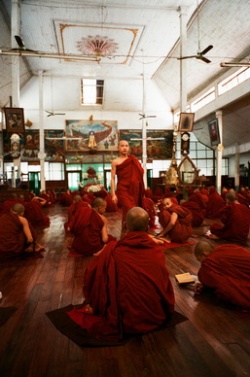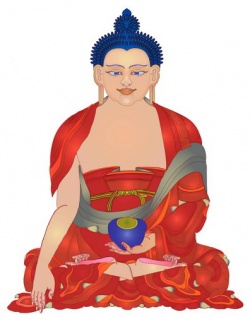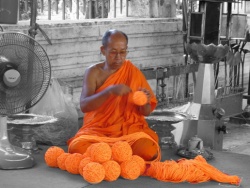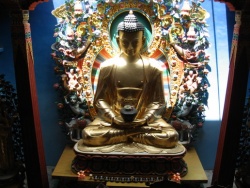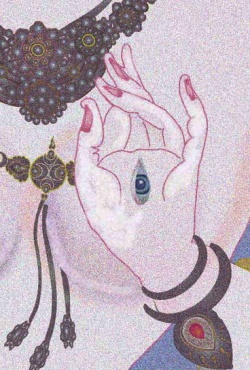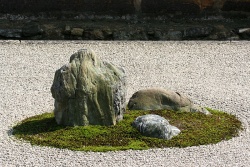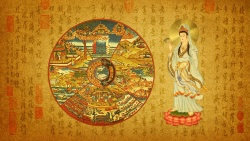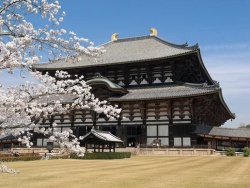Energies and enlightenment
Inner Energies
Scientists of the twentieth century discovered that the entire visible universe consists of matter-energy. All matter, including our bodies and our planet, may convert to energy and vice versa. All forces arise through the interaction of matter-energies. No surprise, then, that the matter-energies within us determine the quality of our inner life. Just as we cannot see electromagnetic or gravitational energy, but only the results of their action, so too we cannot measure or objectify inner energies. But we can experience their action directly. For this we need an acquired taste, a comprehension of what to look for, and a gradual refinement of our perceptions. The understanding of energies brings crucial support to our spiritual path, because energies provide the fuel, the light for all our experiences.
Each energy defines a particular mode of being, a particular kind of world. The energy with which we operate at any given moment determines the kind of experience we have, the kind of world we live in, and the possible modes of operation of our will. The study of the spiritual worlds and their associated sacred energies is an ancient endeavor, with roots in Christian, Buddhist, Hindu, Sufi, Taoist, Kabbalistic and other sources. J.G. Bennett gives a particularly clear and modern account in his book Deeper Man [1]. His concepts and terminology form the basis of this presentation of energies.
The inner energies constitute a hierarchy. Actions undertaken with a higher energy can organize and subsume a lower energy. Lower energies can form a field in which higher energies may be contained, created, and transformed. Remarkably, we are able to transform a wide range of energies within our bodies and souls. At the simplest level, we transform food and oxygen to create the energy that powers our bodily actions. But this human ability to transform energies runs right up the scale toward the most sacred and likely stands as a major reason for the existence of life. Spiritual practices include methods for recognizing, containing, creating, and transforming progressively higher and finer energies. At first we study the energies to recognize their presence and action. Later we must shoulder the burden of learning not to waste our energies unnecessarily or misuse them. Finally, we contact, collect, organize, and transform energies directly, gradually refining our ability to do so.
As we advance on the path, the higher energies grow even more important to us, because only through their action on us can we find real transformation. And by becoming an instrument for the descent of the higher energies into this world, we serve not only our own soul, but also our fellow travelers through this life.
Energies characterize the stages of spiritual development. The pure-hearted occupy a spiritual station of a higher energy than the rest of us. When we are more deeply present, we live in a richer, more substantial, and more truly satisfying world than we experience with a perennially scattered attention.
In the articles linked below, we briefly describe each step in the scale of energies beginning with the energy of our physical life.
See Vital, Automatic, Sensitive, Conscious, Creative, Love, and Transcendent energies.
Vital Energy
I once saw a just-captured, rather fearsome leopard pacing its cage in a Mexican jungle. Exuding strength and vitality, this dignified predator was no zoo animal. Stunningly beautiful and powerful, the leopard radiated a palpable, rippling energy. Some people, such as athletes in top condition, also exhibit an abundance of vital energy, the energy of physical life. When the glow of vital energy abounds, our bodies wax vigorous and ready for action. When the level of vital energy drops, our bodies grow tired or ill. Proper rest, food, exercise, and energy breathing feed our vitality and contribute to good health. Emotional stress, unnecessary muscular tensions, fidgeting, overconsumption of alcohol or food, and other wasteful activities sap our vitality.
In our spiritual life, vitality matters because a depleted or distressed vitality may limit the quality of our contact with the higher energies. Conversely, contact with the higher energies often produces a remarkable cascade of vitality. Proper care of our body creates the vitality that supports our very life and sets the stage for our spiritual work. But the diminished vitality of aging and illness may inhibit our inner work. So while we have the vital strength, we work.
Automatic Energy
Have you ever gotten into the shower, shampooed your hair by habit, and a moment later stood there in the shower wondering whether you had shampooed yet? Have you ever looked for your glasses, only to find them on top of your head? My favorite example: sitting at dinner, frantically looking all around for my fork, until I finally discovered it in the least expected place – in my hand. To see the automatic energy in action like this is a sobering event. Whatever we do under the automatic energy, we only partially experience and only vaguely remember. We live and act in a pre-programmed mode: if A happens, we do B, every time, and without the consideration or participation of our cognizing self. Nevertheless, the automatic energy has its important uses.
Awkwardness reigns when we first learn a complex task, such as driving a car. Its unfamiliarity forces us to think about where the gas pedal is, where the brake pedal is, which foot to use, where the rearview mirrors are, what the traffic signs and signals mean, when we have the right-of-way, and so on. Thinking how to drive makes us clumsy and inefficient, as we use the mind to do the body’s work. Eventually, we learn to drive with ease when it all becomes automated: the appropriate responses emerging without needing to think of them. Our body drives the car while our mind freely engages in conversation, listens to the radio, plans our day, or considers higher level driving strategies like how to bail out of a traffic jam. The driving itself happens automatically.
The automatic energy can work in the body, in the mind, and in the heart. We learn to play a musical instrument, play a sport, brush our teeth, walk, type on a keyboard, speak and read a language, know the product of 7 times 8, recognize a face, and recall a name — all with the help of the automatic energy. For such purposes, the automatic energy finds its appropriate place: directing repetitive or simple processes, thereby freeing up the higher energies for tasks befitting them.
The nearly continuous stream of random, loosely connected, aimless thoughts and images that flows through our mind usually carries us with it and prevents us from being fully present in the moment. This persistent current of automatic thought all too often captures our attention, drawing us into passivity in a dreamlike world, disorganizing and usurping the higher energies of sensation, consciousness, and creativity.
Another problem with the automatic energy occurs when it acts in ways that deplete us. Our habitual and unnecessary muscular tensions burn energy we could better use elsewhere. Our bad habits drain us: smoking, excessive drinking, overeating - all due, at least in part, to misuse of the automatic energy, letting it control rather than serve.
Automatic emotional reactions to life situations, such as anger, rage, fear, jealousy, lust, greed, timidity, and sadness, may be appropriate and even useful for a brief period. But when we allow our automatic energy to run with them, unseen by consciousness, our thoughts and feelings dwell on the reactive emotions. We wallow in them to the point where they take a central role in our inner life, controlling us. All manner of social and psychological troubles result.
The automatic energy, while useful and even necessary, does not bring us into real contact with life. To our unrecognized misfortune, we live almost exclusively under the domination of the automatic energy, enthralled by our habits and conditioning, forever repeating similar patterns of behavior, inner and outer. Our lives pass us by without our participation. Centered in the automatic energy, we are, in effect, asleep. We relish anything that temporarily alleviates the dullness. We even go for strong reactive emotions or thrill seeking, substituting them for a freer, more satisfying, non-automatized way of living. The proven remedy is to embark on a path of spiritual practice leading to greater wakefulness and greater awareness in the midst of normal life.
.............................................................
Sensitive Energy
The basic energy that fuels our inner work and that forms the material of the lower body of the soul is the sensitive energy, which brings vibrant color and vivid impressions to our life. This energy fuels what we ordinarily consider to be awareness, connecting us to our perceptions, to the present moment. Within the sensitive energy we find our medium for actual contact with the particulars of life, for noticing the large and the small. We can breathe. We can taste our food. Though not yet fully awake, we are not as asleep as when the automatic energy dominates our being. Choice, initiative, and independence from merely reacting to events, all become possible. Life is enriched and natural, no longer so habitual.
The possibilities enabled by the sensitive energy are immensely important to the quality of our inner life. Lasting benefits accrue when we explore and understand its role in our emotions, in our thoughts, and in our physical perceptions. We can learn specific spiritual practices to manage, collect, contain, and transform it into higher energies.
In the body, the sensitive energy enhances our kinesthetic and proprioceptive impressions. We can sense directly that we actually have a hand or a leg. Under the automatic energy we move without contact with our body; unless we stub a toe, we walk with no awareness of our feet, like our half-awareness when we drive. The sensitive energy, however, provides a visceral, organic awareness of our body in movement and at rest, bridging the chasm between mind and body. In later sections we suggest methods for learning to be in touch with the sensitive energy in the body, to experience and even direct its flow. When we refer to the Energy Body, we mean the sensitive energy. Intentionally sensing the body affords a powerful grounding in the present, a most useful method on the spiritual path.
In the mind, the sensitive energy enables us to be aware of thoughts as thoughts. With the automatic energy, thoughts pass through our mind and we pass along with them, carried unawares by our thought stream. With the sensitive energy, we know our thoughts, we know their meaning, and can solve problems by intentional thinking.
In the emotions, the sensitive energy brings awareness of the spectrum of feelings passing through our heart. With the automatic energy, our emotions have us, we lose ourselves in them. With the sensitive energy we feel our emotions as emotions, without being completely lost or entrapped in them.
As the highest energy under our direct control, the sensitive energy provides the immediate, tangible substance of our spiritual work. Through practice we can collect and organize it into a robust whole, the basis of the lower part of our soul, a firm foundation and container for the higher energies, a platform from which to live a less-dreamlike, more natural and organically joyful life.
The world of the sensitive energy corresponds to the worlds known as Asiyah (Action) in Kabbalah and Ajsam (Bodies) in the Sufi cosmology.
..........................................................
Conscious Energy
Left-click for MP3 audio stream, right-click to download
Though the reality they point to is fundamental to our possibilities, we use the terms “conscious” and “consciousness” rather loosely. Usually we mean them to indicate a simple sensory awareness. So when we say “I am conscious,” or “I am conscious of” something, we actually refer to the working of the sensitive energy, the substance of our awareness of our bodies, thoughts, emotions, and sensory perceptions. Here we adopt a quite different meaning for the term consciousness: the spacious, empty, infinite, cognitive field that forms the ever-present background of all awareness. In this sense, the full experience of consciousness is rare and fleeting in our lives. But to taste true consciousness, you need only place your attention through the gap between thoughts, into the cognizant space surrounding your thoughts.
Reworking an analogy due to J. G. Bennett (Energies 1964, p. 90), if we compare the sensitive energy to the images on a movie screen, the conscious energy forms the screen itself. Consciousness enables us to be aware of our sensitive awareness. The still pool of consciousness underlies, permeates, and surrounds our ordinary awareness, in the relationship of context to content. This cognizant stillness of pure consciousness corresponds to sitting in the darkened movie theater with no images on the screen, nor sounds from the audio system. Like the screen during the movie, the subtle blank slate of consciousness remains profoundly difficult to recognize, because of its inherent emptiness. Chronically immersed in and concealed by our sensitive energy, consciousness usually remains indistinct and lost to us. The sensitive energy movie so captivates us that we lose ourselves. Transported by the images, we forget the theater, the screen, and even our own existence.
Sensitivity affords awareness of particulars, the content of life: an arm, a leg, a thought, a sound, the person in front of us. Consciousness affords contextual awareness. We recognize thoughts as just thoughts. With the automatic energy, thoughts run on their own by association, bouncing off each other and off sensory impressions. With the sensitive energy we are in contact with the meaning of our thoughts, we can engage them, intentionally direct them, and think sequentially on a subject or problem. We can think logically: if A then B, if B then C, and so on. With consciousness, we move to a higher perspective to see thoughts as thoughts. In conscious thinking, we can focus on a topic, allow our thoughts to gather around it, and see what combinations offer new insight. We can think holistically, seeing and considering all aspects at once.
Automatic emotions react on their own to thoughts, to other emotions, and to external events, thereby driving our feelings haphazardly and with no oversight. The sensitive energy puts us in contact with what we are feeling. We can feel our emotions. But we can also feel consciously. The conscious energy enables us to see our emotions as emotions, to let them come and let them go, to not be under the spell of identification that we are what we feel. In the same way that we are not the objects we see, we are also not our thoughts or feelings. The paradigm of conscious emotion is equanimity, a pervasive tenor of peace and calm. But any emotion can be conscious. Conscious anger, for example, is an awakened person’s response to evil deeds. Conscious emotions do not come from egoism and we are not identified with being the feeling. We allow the emotion appropriate to the situation and, while we feel it fully and deeply, we are never overwhelmed or controlled by the emotion. There are also higher emotions that come from beyond consciousness, such as love and compassion for all, and longing for the Divine.
Consciousness brings awareness of ourselves and our surroundings as a whole. Lacking boundaries, more than personal, consciousness permeates everything. We cannot have it, but we may participate in it. Yet consciousness also provides a distinctive sense of being ourselves.
Attention is a form of will and acts through the conscious energy. Since attention can direct our senses and our sensitive energies, it must use a higher energy, in this case consciousness. The conscious energy responds directly to will, to attention, and mediates the action of our will in the sensitive and lower energies.
The pivotal importance of the conscious energy in our spiritual work cannot be overstated. Consciousness both connects us with will and forms the frontier of the truly spiritual realms. Spiritual practices, such as presence, work to raise consciousness out of sensitivity and give us access to it. Awareness of bodily sensations organizes the sensitivity into a less chaotic and more stable vehicle in which consciousness may assume its rightful place.
The conscious energy resides in an eternal, timeless dimension, deathless and unchanging, not subject to the conditions of space and time. Coming into the vast stillness of consciousness is like entering a large cathedral, temple, or mosque. The expansive ceiling and cavernous space open to a new kind of freedom and a substantive peace. That great hall of peace is always here, just beneath our ordinary perceptions, where consciousness invites our participation in the world beyond me and mine. Though our contact with consciousness certainly varies, it constitutes the all-pervasive bedrock of our inner world, the continuum of cognizance, the plenum of peace.
At the same time, many of today’s major writers and commentators on spiritual subjects overrate consciousness, confusing the ultimate expansion of consciousness with God. Consciousness is indeed unbounded and infinite. The alternative names applied to experiences of the true nature of consciousness include presence, non-dual awareness, and in its more expansive form, cosmic consciousness. Spiritual seekers can mistake the boundlessness and peace of consciousness for nirvana or for the ultimate nature of God. While God may manifest at the level of the conscious energy, God also resides beyond this and all other forms of consciousness. Indeed, consciousness is merely the ground on which God walks. We may more aptly consider God to be associated with Will, with the action of Love and the Divine Purpose than with any of the energies such as consciousness.
Who uses the energies? At the level of our limited world of sensitivity and below, we do. At the level of the universe, God does. The Divine is no more identical with consciousness than we are with the electricity we use to power our gadgets. Nevertheless, we must work to understand and to live in consciousness because of its critical role in forming our being and because it brings us closer to will, to “I am.”
The world of the conscious energy corresponds to the worlds known as Yetzirah (Formation) in Kabbalah and Arvah (Spirits) in the Sufi cosmology.
..................................................................
Creative Energy
Beyond and veiled by consciousness, behind the spacious stillness within, lies the realm of the creative energy, an ocean of bliss and light, the Primordial Sacred Sun, the hem of the garment that God wears. To become directly aware of the creative energy we must steer our perception outside consciousness itself. Although we might enter the creative world through an act of grace, our reach typically falls far short of that world. Nevertheless, the creative reaches us. So instead of attempting to describe the world of the creative itself, we will look at how it manifests in our life.
The creative makes new connections and opens doors of opportunity. This energy can bring order out of the chaos of the higher energies. The creative domain encompasses synchronicity and karma, sowing and reaping the results of our actions, creating and selecting possibilities. It ushers events into our lives, events meant for us. The power of sex and the perception of beauty derive from this energy.
Only in emptiness can something new be created: the white canvas, the blank sheet of paper, the formless lump of clay. The creative energy introduces us to our essential emptiness, a prerequisite for entering the true depths of the sacred. The reverse also holds: to contact the creative energy we must empty ourselves, through an inner act of surrender. This act of emptying oneself of oneself opens a channel to the creative realm of the spirit, opening our heart to joy, generosity, and peace. The event releases an influx of the lower energies that we experience directly and unambiguously. Vitality, for example, pours down when the creative energy touches us, completely changing the state of our body. Superhuman feats of strength in dire circumstances are powered by the creative energy.
By its name, we would expect the creative energy to be intimately associated with the arts and sciences, and indeed it is. In any of the arts, the artist knows the crucial role of surrender, surrendering to the work, to its needs, to its possibilities. Discipline and training in the methods of the art prepare the artist to be a vehicle of art. Cultivating spontaneity helps open the channel to the creative. The artist empties herself, allowing her acts to be guided by the creative power, often accompanied by ecstasy. This is perhaps most obvious in music. The great musician gives himself over to the music in an ecstatic embrace, becoming an instrument of the music.
Similarly, in the spiritual path, we must empty ourselves to become instruments of the Divine Will. In this emptying, in our malleable nothingness, the creative energy creates our being. It is said that the perfected human, the great saint, the bodhisattva, achieves the station of being centered in the creative energy, able to transmit the higher energy of universal love. Thus, the creative energy serves as the abode of the heavenly host, the devas, the creative wisdom, responding directly to the Divine Will. This is the place of the demiurge, the elohim, agents of the intelligent force that continuously creates and sustains this great universe.
The world of the creative energy corresponds to the worlds known as Beriyah (Creation) in Kabbalah and Imkyan (The Possible) in the Sufi cosmology.
..................................................................
Love and Compassion
The sacred energy of love and compassion, the Great Heart of the World, embraces us all, without condition, unifying all of life, unifying the whole creation within the warm spirit of kindness, appreciation and concern. With good fortune, we may meet people in whom this unfettered love shines strongly, allowing all around to bask in its light. The great saints and bodhisattvas, utterly emptied of themselves, transmit such love and compassion. In some instances of communal worship, the substance of this boundless ocean of love may envelop the whole assembly. It may enter a true marriage and may inform the bonds between parents and children. Whenever we look into another person’s eyes and recognize the sameness, that that person and I are the same, not really separate, this is love.
Despite appearances to the contrary, Divine love and compassion suffuse every corner of the world, even our own. Divine love stands before the awesome contradictions in our lives: our God-given freedom that offers the promise of profound joy as well as the suffering attendant on living. The Divine heart of compassion celebrates the beauty of the freedom within each person, a celebration made bittersweet by the price of freedom: inevitable suffering.
When we hear of or see another person’s misfortune, and we feel the pang of their suffering, and are moved to extend the help that lies within our power, this is compassion. For this we need strength, because suffering lies all around us. The daily news’ litany of catastrophes and evil deeds, large and small, could devastate us, were we awake to the whole of it and lacked the strength to bear it. But awakening through spiritual practice brings its own strength. And the suffering we see is more than balanced by the joy that flows to us along with love, protecting the compassionate from being overwhelmed by the force of suffering.
Universal love lies far beyond its pale imitation in the lower energies, where emotional attachment turns from “love” to hate, jealousy, or despair. Nevertheless, the world is so constructed that it remains within our possibilities to participate in love knowingly. But that can only happen to the degree we empty ourselves of ourselves.
Self-referential motives, self-centeredness, attachment, expectation of something in return, grasping, setting of conditions, partial-heartedness - none of these have any place in love and, in practice, completely block the action of love. Placing ourselves first and at the center forecloses the possibility of love. Yet moments do come even to us, perhaps with our children or our pets or unexpectedly with a stranger, when we are briefly free of egocentric attachment and the true heart of objective love opens within us. In unguarded moments, our natural response to people is friendship, one of the faces of love. To be able to love is a goal lofty and worthy enough to sustain our long journey along the path, drawing us ever forward.
Our common mother, the Earth, also loves, loves each one of us and all life in her biosphere. Like a self-centered and petulant child, we only too rarely return this love. And like a child, we so take for granted the love of our mother Earth, that we do not even recognize it. Yet her love is there for us individually, in nature and in the city, if we can but open to it. One simple expression of it manifests as the beauty with which nature adorns herself. And there are other more direct expressions we may perceive, including a reservoir of spiritual energies within the Earth that we can draw upon. But as a species, we need to mature and not expect the Earth to continue indefinitely absorbing every insult and injury we pile upon her. We push these limits at the Earth’s, and our own, peril. The Earth gives and gives and gives, perhaps more than she can afford. But because our material strength now exceeds our collective wisdom, the Earth needs us to find a place in our hearts for her. By our inner work, by opening to higher energies, by purifying our will and intentions, we help cleanse our collective will, raise our collective level of being, and give back to the Earth and to human society. And we do this for love.
Love manifests in many forms, but always serves to unify. Love’s unmistakable hallmark dissolves our veils of isolation and separation, allowing us to become more fully ourselves within the sweet scent of merging. Out of love we are born, and into love we depart. In between, we seek love and love seeks us.
The world of universal love, a world beyond all forms, even beyond the world of light, corresponds to the worlds known as Atzilut (Emanation) in Kabbalah and Lahut (Boundless) in the Sufi cosmology.
...........................................................................
Transcendent Energy
The names abound: God, the Most High, the Unconditioned, the Divine, the Unfathomable, Allah, Nirvana, Brahman, Adonai, the Real, the Deathless, the Omnipresent, the One, the Unique, the Tao, the Absolute, Ein Sof, the Void. Not only does everything arise from the transcendent Source, but It also exerts the one powerful attraction on us all. Every other attraction merely misappropriates and distorts the primal draw of the Source. We call the abode of the Source the Transcendent Energy, the holy mountain.
With a wild, chaotic, and powerful freedom, this ultimate energy acts as the direct vehicle of the Divine Purpose, the Will of the World, the Creator and Sustainer of the Universe. Beyond space, beyond time, the Transcendent intimately touches everything within space and time, working through Its intermediaries of universal love and the creative energy, endowing life with freedom and the possibility of return.
By creating a coherent soul built of the energies of sensitivity, consciousness, and the creative, emptied of attachments and personal desires, with a profound yearning to serve the Greatness, a human being can have real hope of contact with the Transcendent Energy and the Divine Will. The deconditioning of our mind-heart opens the door to the Unconditioned, and utter surrender is the act of walking through.
As Guru Padmasambhava puts it in Self-Liberation through Seeing with Naked Awareness:
Appearances are not erroneous in themselves, but because of your grasping at them, errors come into existence.
But if you know that these thoughts only grasp at things which are mind, then they will be liberated by themselves.
Everything that appears is but a manifestation of mind.
Even though the entire external inanimate universe appears to you, it is but a manifestation of mind.
Even though all of the sentient beings of the six realms appear to you they are but a manifestation of mind.
Even though the happiness of humans and the delights of the Devas in heaven appear to you, they are but manifestations of mind.
Even though the sorrows of the three evil destinies appear to you, they are but manifestations of mind.
Even though the five poisons representing ignorance and the passions appear to you, they are but manifestations of mind.
Even though intrinsic awareness, which is self-originated primal awareness, appears to you, it is but a manifestation of mind.
Even though good thoughts along the way to Nirvana appear to you, they are but manifestations of mind.
Even though obstacles due to demons and evil spirits appears to you, they are but manifestations of mind.
Even though the gods and other excellent attainments appear to you, they are but manifestations of mind.
Even though various kinds of purity appear to you, they are but manifestations of mind.
Even though (the experience) of remaining in a state of one-pointed concentration without any discursive thoughts appears to you, it is but a manifestation of mind.
Even though the colors that are the characteristics of things appear to you, they are but manifestations of mind.
Even though a state without characteristics and without conceptual elaborations appears to you, it is but a manifestation of mind.
Even though the non-duality of the one and the many appears to you, it is but a manifestation of mind.
Even though existence and non-existence, which are not created anywhere, appear to you, they are but manifestations of mind.
There exist no appearances whatsoever that can be understood as not coming from mind.
Source
sgforums.com [[[Buddhist Cosmology]])


